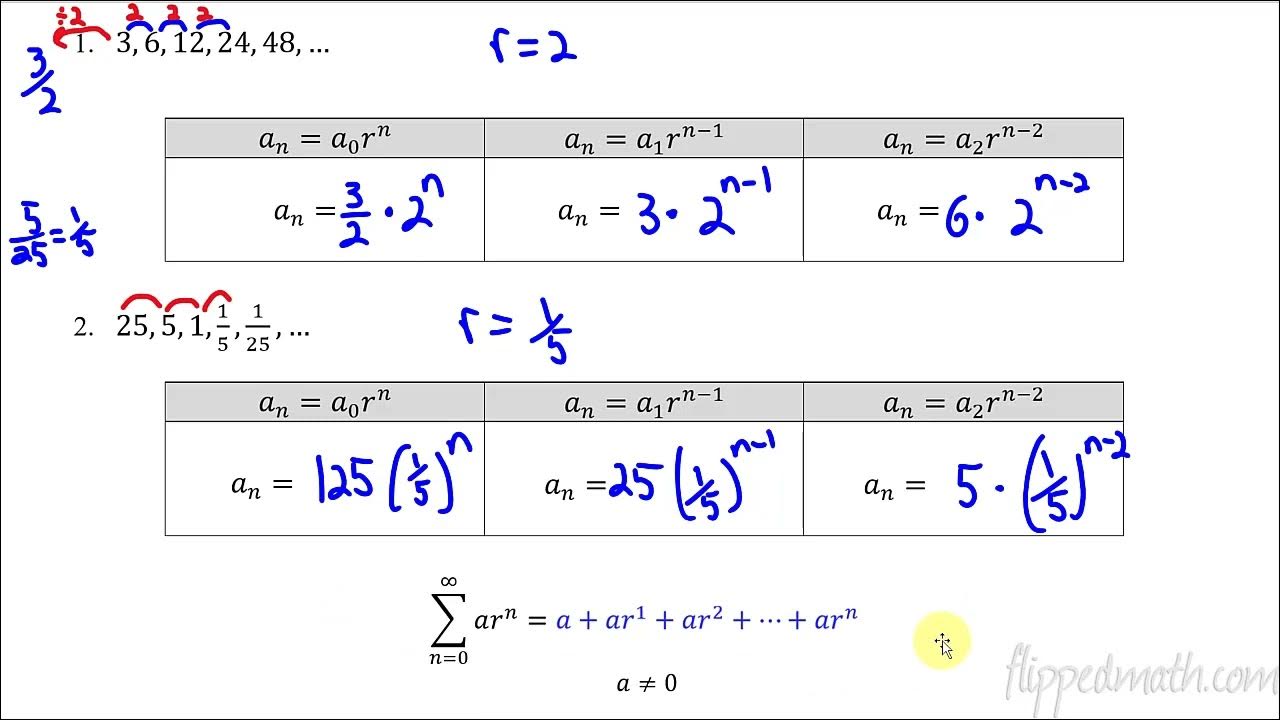Calculus BC – 10.9 Determining Absolute or Conditional Convergence
TLDRIn this calculus lesson, Mr. Bean discusses series convergence, focusing on absolute and conditional convergence. He explains that a series converges absolutely if the sum of its absolute values converges, and conditionally if it converges despite the sum of its absolute values diverging. The lesson includes examples and tests, such as the ratio test, to determine convergence type. Mr. Bean also covers special cases involving absolute value inequalities in series, providing a comprehensive review of convergence tests from Unit 10, preparing students for exams.
Takeaways
- 📚 Today's lesson focuses on absolute and conditional convergence in series.
- 😷 The instructor mentions recovering from COVID-19 and apologizes for any potential coughing.
- 🔢 Absolute convergence occurs if the absolute value of a series converges, implying the original series also converges.
- 🔍 Conditional convergence happens when the absolute value of the series diverges, but the original series converges.
- ➗ The ratio test is a key tool for determining the convergence of series.
- 🧪 Example 1: A series where absolute value converges using the ratio test, leading to absolute convergence.
- 💡 Example 2: A series where absolute value diverges but the original series converges, indicating conditional convergence.
- 🚫 Example 3: Both the absolute value and the original series diverge, showing divergence.
- 📝 Alternating series test: Two conditions need to be met for an alternating series to converge.
- 📏 The lesson includes solving absolute value inequalities to find the interval of convergence for series.
Q & A
What is the main topic of the calculus lesson presented by Mr. Bean?
-The main topic of the lesson is the concept of convergence in series, specifically focusing on absolute and conditional convergence.
Why does Mr. Bean apologize at the beginning of the lesson?
-Mr. Bean apologizes because he has just recovered from a case of COVID-19, which might affect the quality of his voice during the lesson.
What are the three possible outcomes for a series according to the lesson?
-The three possible outcomes for a series are that it converges absolutely, converges conditionally, or diverges.
How does Mr. Bean explain the difference between absolute and conditional convergence?
-A series converges absolutely if the series of its absolute values also converges. A series converges conditionally if the series of its absolute values diverges, but the original series converges.
What test does Mr. Bean use to determine if the absolute value of a series converges?
-Mr. Bean uses the ratio test to determine if the absolute value of a series converges.
Can you provide an example of a series that Mr. Bean discusses in the lesson?
-One example Mr. Bean discusses is the series with terms 3^n / n!, which he tests for absolute convergence.
What is the significance of the ratio test result being less than one in the context of the lesson?
-If the result of the ratio test is less than one, it indicates that the series (or the absolute value of the series) converges.
What does Mr. Bean suggest for students who are struggling with the material?
-Mr. Bean suggests that students who are struggling should review their notes from Unit 10 and use the lesson as an opportunity to reinforce their understanding of the tests they've been doing.
How does Mr. Bean demonstrate the process of checking for conditional convergence?
-Mr. Bean demonstrates checking for conditional convergence by first showing that the absolute value of the series diverges and then using the alternating series test to show that the original series converges.
What is the nth term test for divergence that Mr. Bean mentions?
-The nth term test for divergence involves taking the limit of the nth term of a series as n approaches infinity and showing that if this limit is not zero, the series diverges.
How does Mr. Bean handle the complexity of absolute value inequalities in the lesson?
-Mr. Bean handles absolute value inequalities by breaking them down into two separate inequalities and solving for the variable within the range where the series converges absolutely.
What is the purpose of the additional examples provided by Mr. Bean towards the end of the lesson?
-The additional examples are meant to provide practice for students, especially in preparation for an AP exam, and to illustrate the application of concepts learned throughout the lesson.
Outlines
📚 Introduction to Convergence Concepts in Calculus
This paragraph introduces the topic of convergence in calculus, specifically focusing on whether a series converges absolutely or conditionally. The speaker, Mr. Bean, apologizes for any disruptions due to recent illness and proceeds to explain the three possibilities for a series: absolute convergence, conditional convergence, or divergence. The importance of understanding the absolute value of a series is emphasized, and the speaker outlines the plan to provide examples for each scenario, using tests from Unit 10 to analyze the series.
🔍 Analyzing Absolute and Conditional Convergence with Examples
In this section, Mr. Bean discusses the process of determining whether a series converges absolutely or conditionally by examining the absolute value of the series first. He provides an example of an alternating series and uses the ratio test to demonstrate that the absolute value of the series converges, implying absolute convergence of the original series. The speaker then moves on to an example where the absolute value of the series diverges, but the original series converges, indicating conditional convergence. The importance of applying knowledge from Unit 10 is reiterated, and the alternating series test is introduced to analyze the convergence of the original series.
📉 Exploring Divergence and Complex Convergence Scenarios
This paragraph delves into scenarios where both the absolute value and the original series diverge, using the nth term test for divergence as a demonstration. The speaker also presents more complex examples that might be encountered on an AP exam, involving taking the absolute value of the ratio test. The process of solving absolute value inequalities to determine the interval of convergence is explained, showcasing the application of algebraic techniques in calculus problems. The paragraph concludes with a brief mention of practicing these concepts for mastery.
📝 Concluding the Lesson with Conditional Convergence Check
The final paragraph wraps up the lesson by addressing the concept of conditional convergence. Mr. Bean explains how to check for conditional convergence at specific points by plugging in values into the original series and examining its behavior. He provides an example where the series converges conditionally at x equals 0 but not at x equals 2, highlighting the difference between absolute and conditional convergence. The speaker encourages reviewing the lesson to prepare for tests and to practice using the provided materials, before signing off.
Mindmap
Keywords
💡Convergence
💡Absolutely Convergent
💡Conditionally Convergent
💡Diverges
💡Ratio Test
💡Alternating Series Test
💡nth Term Test for Divergence
💡P-Series
💡Absolute Value
💡Conditional Convergence
Highlights
Introduction to the concept of series convergence, specifically focusing on absolute and conditional convergence.
Explanation of the importance of distinguishing between absolute and conditional convergence in series.
Apology for the instructor's recent recovery from COVID-19 and its potential impact on the lesson delivery.
Three possibilities for a series: absolute convergence, conditional convergence, or divergence.
Definition of absolute convergence and its significance in series evaluation.
Conditional convergence explained as the scenario where the series converges despite the absolute value diverging.
Demonstration of how to apply the ratio test to determine the convergence of the absolute value of a series.
Example of a series that converges absolutely using the ratio test.
Illustration of a series where the absolute value diverges but the original series converges, indicating conditional convergence.
Application of the alternating series test to confirm the convergence of a series with conditional convergence.
Case study of a series that diverges both in its absolute value and the original form.
Introduction of the nth term test for divergence and its application to a series.
Explanation of how to handle absolute value inequalities in the context of series convergence.
Example of determining the interval for which a series converges absolutely using absolute value inequalities.
Discussion on how to identify conditional convergence by checking the endpoints of the interval for absolute convergence.
Practice examples provided for students to apply the concepts of absolute and conditional convergence.
Emphasis on the importance of reviewing all the tests from Unit 10 for effective understanding of series convergence.
Conclusion summarizing the key points of the lesson on series convergence and the practical steps to determine it.
Transcripts
Browse More Related Video

AP Calculus BC Lesson 10.9

Conditional and Absolute Convergence for Infinite Series

Absolute and Conditional Convergence

Calculus BC – 10.2 Working with Geometric Series

Conditional & absolute convergence | Series | AP Calculus BC | Khan Academy

Calculus 2 Lecture 9.6: Absolute Convergence, Ratio Test and Root Test For Series
5.0 / 5 (0 votes)
Thanks for rating: